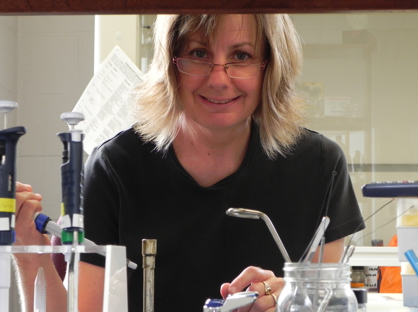In pine forests, root and butt rot fungi cause significant damage and economic loss. Currently, there are few effective strategies to control these pathogens, especially since application of antifungal chemicals is prohibited in many countries. I and collaborators Dr. Eugenia Iturritxa and Dr. Nebai Mesanza from Neiker-Tecnalia, Arcaute, Spain, who are experts in fungal pathogens in forests, have isolated bacteria from the roots of a healthy Monterrey pine tree that inhibit growth of the fungi and increase the survival of young trees. These bacteria may be applied as a nursery treatment to mitigate damage caused by the fungal pathogens. The success of this treatment depends on the ability of the bacteria to stably colonize young roots, which we assessed in this project.
To visualize the bacteria on roots, we tagged them with green fluorescent protein and watered young pine trees with a suspension of each of the fluorescent bacteria. The roots were visualized microscopically and the bacteria were quantified by measuring the amount of green fluorescent protein periodically for more than 30 days. Both bacterial strains were present on the roots within one day of soil application and the population increased in the first few days. Over the course of the experiment, fluorescent bacteria were found all along the roots, forming small colonies especially in regions where nutrients are released such as root hairs, root tips, and emerging lateral roots. One strain was present mainly on the root surface while the other was also found inside the root tissues. Our results indicate that the bacteria can stably colonize pine seedling roots and are a promising treatment to reduce losses in forests from fungal pathogens.
We received a grant from The Canadian Tree Fund in 2018 that helped us achieve our goal by providing funds for research materials (e.g., seeds, pots, soil) and for user fees for confocal microscopy at the University of New Brunswick (UNB) Microscopy and Microanalysis Facility. It also contributed to travel expenses for Dr. Mesanza to visit UNB to conduct the research. Additional funding for the project was provided by European Union Life Healthy Forest grant to Dr. Iturritxa. The results of this research have been published in the journal Forests (10:552, 2019; https://doi.org/10.3390/f10070552).
Dr. Cheryl Patten, Principal Investigator
- Mesanza1,2, B.D. Crawford1, T.J.D. Coulson1, E. Iturritxa2, and C.L. Patten1
1Biology Department, University of New Brunswick, Canada; 2Production and Plant Protection, Neiker Tecnalia, Spain

